Human's Impact on the Oceans| Humans have had a huge impact on the ocean. In fact, evidence of humans can be found all over the oceans, even in the most remote polar areas, in the form of floating trash. The main areas of human impact can be divided into those related to ocean pollution, habitat destruction, and the introduction of alien species. Each of these deserves an entire chapter but will just be summarized here. Interested students can pursue a term paper regarding these topics or enroll in an Environmental Biology course. |
'Drains to Ocean' plaque placed by storm drains in streets near the ocean, in Santa Barbara, California, to alert the public that anything dumped into the storm drain will not be processed and will go directly to the ocean. (GA image) |
The definition of 'pollute' is "to make impure, especially to contaminate with man-made waste." Humans have a lot of 'waste' that is often disposed of in the ocean - trash, sewage, oil, chemicals, heat, and even 'noise' to name a few. As the human population increases on Earth these sources of pollution increase. In small amounts much of this pollution does not harm the ocean ecosystems. In fact, sometimes the addition of food waste can increase the productivity of an area by supplying an added food source for the marine animals. But, this is always altering the 'natural state' and in most cases becomes destructive in the long run.
Trash is one of man's most widespread pollutants. Beaches all over the world become littered with the trash produced by mankind - much of which is disposed of at sea and then floats all over the world in the currents. Remember that all oceans of the world interconnect so anything put in one ocean could conceivably end up anywhere on Earth, and it does. The picture of a beautiful beach in Hawaii littered with trash from across the oceans was introduced in lesson 2.4.5. To combat this, many people have become part of an international "Beach Clean Up" every fall when volunteers walk hundreds of miles of beaches, picking up trash and disposing of it properly. In August 2006 the Santa Barbara News Press newspaper reported on an area between Hawaii and California which has six times more plastic (by weight) than plankton. This area was the center of one of the North Pacific gyres (where the currents go round and round) and thus once plastic enters this area it never leaves. Since most plastics do not break down this is a problem that will not go away without help from man.
Sewage is a pollutant that can be harmful to human health. Most developed countries treat their sewage to get rid of harmful human bacteria and release relatively benign effluent into the oceans after treatment. This works well except in two cases. One case is when the sewer plant may become overloaded with sewage and unable to treat it (which may happen during rain storms if the rain water is directed into storm drains that go to the sewer plant). Because of this many cities now have storm drains that take the runoff water directly to the ocean (which can be another problem if this water is contaminated). The second case is when areas have watersheds that build up sewage (usually due to improper septic systems or people using the watershed as an outdoor outhouse). At the first rain, these watersheds are flushed into the ocean and extremely high levels of human sewage contaminates the beaches. Many cities now test their ocean water (sometimes weekly) and publicly post the results - closing beaches where the human sewage levels may pose health risks. |
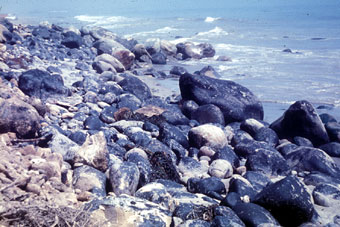 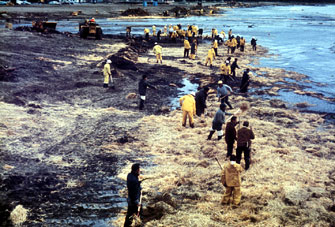 |
Rocky shoreline in Santa Barbara during 1969 oil spill (left). Sandy beach in Santa Barbara during 1969 oil spill (right) showing use of hay to absorb oil. This soiled hay was disposed of in a land fill. (Images, with permission, from Western Marine Lab) |
Oiled birds (above) on the shoreline during the Santa Barbara oil spill in 1969. (Images, with permission, from Western Marine Lab) |
Oil spills in the ocean usually happen when an ocean oil rig springs a leak or when an ocean going tanker (carrying oil) wrecks. Several large oil spills have resulted from these two means (the Santa Barbara spill in 1969, and the Exxon Valdez spill in Alaska in 1989. Oil dumped down storm drains that lead to the ocean also may be a source but most areas now have signs to help prevent this. War can also create oil spills as it did in 1991 when the Gulf War resulted in millions of gallons of oil being released into the Persian Gulf. Oil spills initially may kill large numbers of marine life however, most of the benthic invertebrates are capable of rather speedy recoveries (6 months to 5 years depending on the area and spill) because they have tremendous numbers of planktonic larvae that are drifting in the ocean water and relatively fast growth rates to adult size. The hardest hit during most oil spills are the marine birds - few recover even if they are cleaned, fed until they molt (getting a new set of feathers) and released.
Chemicals released into the ocean cause a myriad of problems. Pesticides, coming from runoff of agricultural land into the ocean damages marine organisms. When DDT was being used (as an insect spray on crops), this chemical ended up in the food chain and caused sea birds, like the brown pelican, to lay eggs with soft shells. This resulted in the brown pelican eggs almost all breaking before the baby could develop and the near extinction of this species. In this case DDT was eliminated in most countries and the brown pelican population eventually recovered in most areas. Another sad example happened in the 1950s when mercury was released into the ocean in Minamata, Japan. The mercury got in the food chain and over a hundred Japanese living in the area became poisoned by eating the shellfish - resulting in birth defects, insanity, and death. These are just a few examples of the problems with chemicals released into the ocean.< |
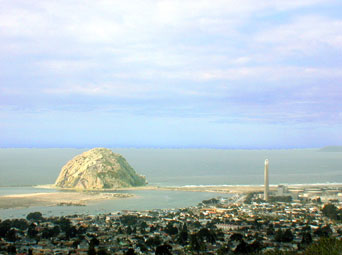 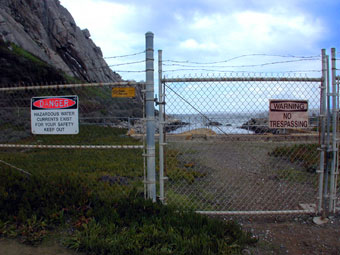 |
Thermal pollution may come from power plants such as the one at Morro Bay, California (image at left, the tall towers are the power plant near Morro Rock) that take in cool ocean water and release it a few degrees warmer. At Morro Bay the warm water is released right next to Morro Rock (image at right is the thermal effluent right next to Morro Rock. (GA images) |
Thermal pollution is a byproduct of the ocean's use as a cooling agent - the cool ocean water taken in is released at a higher temperature. Although the temperature of release is usually controlled by laws, and is not such a threat as the other forms of pollution mentioned here, one could imagine what it would be like if more and more plants began using ocean water as a coolant. This change in temperature, due to humans in this case, would change the makeup of the species in these areas.
Noise pollution is one of the more recent threats to marine life. Several studies have shown that the noise produced by boats interferes with many species of marine life. The number of large tankers now cruising the oceans creates a significant level of noise that may make it difficult for whales to communicate. The other source of noise pollution comes from the testing of loud noises in the oceans (mostly by the military) which have been linked to the deaths of dolphins (a type of small whale) due to massive internal hemorrhaging. |
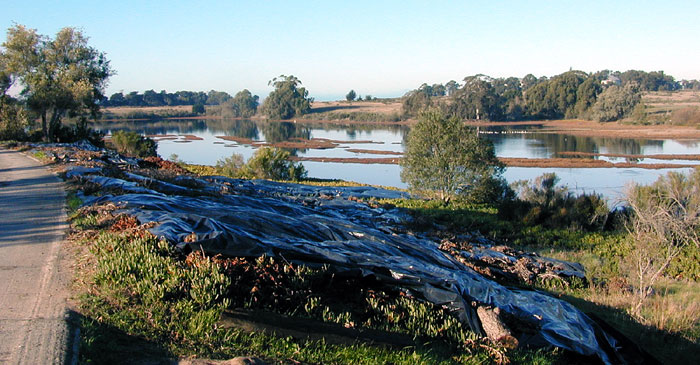 |
Habitat restoration at a salt marsh near Santa Barbara - Devereux Slough. The black plastic is killing off areas of disturbed habitat so that it can be restored to a salt marsh. This slough is one of only a few left in California - most have been filled in for homes, businesses and airports. (GA image) |
Habitat destruction occurs directly when man 'develops' marine areas by filling them in with sediment to create more usable acreage. Most of the natural estuaries in California have been 'developed.' In Ecuador many mangrove (a tree that lives by the ocean and is the base for a mangrove community) communities have been converted into ponds for shrimp mariculture. The list goes on and on - leaving the marine creatures without a suitable habitat in which to live. Pollution can also create habitat destruction by making the area unfit.
Restoration of habitats is becoming increasingly common in developed countries that are concerned about the effects of humans on nature. Several large restoration projects concern the marine environment. |
A sign alerting ocean going people to alien species in Morro Bay, California. (GA image) |
Introduction of alien species is usually caused by our shipping industry. Ships, traveling worldwide, pick up marine species both on the hulls of their ships and in ballast water. As they travel the globe, these species can be introduced to new areas. Probably most of these species die because the environment is not right for them but a few survive and may out compete the native species, leaving an unbalanced ecosystem. In California the Chinese mitten crab (Eriocheir) is an example of a recent introduction that is out-competing the native species and causing problems.
Accidental introductions of alien species may happen with the aquarium trade. Caulerpa taxifolia is a pretty Australian green algae that is often sold in aquarium stores. It is easy to grow in an aquarium but if released into the ocean is spreads and kills everything (plants and animals). It can grow from a tiny piece of the stem or root. It is usually introduced from unknowing aquarists dumping their water into the ocean or down storm drains. In the Mediterranean, off Monaco, this algae was left untreated and it has essentially ruined the marine habitat there with little chance of containment. It was found in small patches in two places in Southern California where conservationists immediately set to work covering the patches with a tarp and injecting chlorine under the tarp. The chlorine kills all life forms. In summer 2006 it was announced that Caulerpa taxifolia had been eradicated from these two places in California (a harbor in Huntington Beach and a lagoon in Carlsbad). Successful eradication of alien species is unique and this Southern California result is probably because it was discovered early and both places were in calm areas (where pieces of the algae were not spread around by waves and currents). |
 |
Newspaper headlines highlighting global changes in the Arctic. (GA image) |
Other global changes may be due to humans such as global warming and ozone depletion due to materials released into the atmosphere by humans. These effects have several different interpretations which should be carefully reviewed.
Scientists record yearly changes in marine animal populations that may be linked to global warming. Since 2000 the health of the polar bear populations (that you learned about in 'The Arctic' lesson of the Bottom Dwellers chapter) appears to be threatened due to the warming of the Arctic areas. The polar bears feed 'on' the ice and as the ice is depleated they have not only habitat loss but must swim farther between patches of ice. This increases their energy needs which they may not be able to meet with their ability to feed. On the other hand, since 2000 the number of gray whale (that you learned about in the 'Gray Whale' lesson of the Water Dwellers chapter) calves has increased and some scientists think this may be caused by global warming. As the ice melts back faster from the Arctic gray whale feeding areas there may be more habitat available. The gray whales cannot feed under the ice because they are air breathers but they feed on small animals in, and near, the bottom of Arctic waters off Alaska. Prime feeding ground for gray whales is in the Bering Sea and so far it appears that many gray whales are moving farther north in the Bering Sea and into the Chukchi Sea to feed because of the early melting of the ice. Another interesting recent discovery is that a marine plankter known as a salp is increasing in some areas of Earth as ocean temperatures rise. This small animal plankter feeds on phytoplankton (plant plankton). The phytoplankton consumes large quantities of carbon dioxide during photosynthesis and when it is eaten by a salp the salp packages this carbon dioxide in its heavy fecal pellets. The fecal pellets sink to the ocean floor and thus may remove carbon dioxide from our atmosphere. One study quotes that an SUB can emit about 7 tons of carbon dioxide each year and thal one group of salps can package up 4,000 tons of carbon dioxide in fecal pellets each day. This is all very interesting ... but think about whether the carbon dioxide is coming from the atmosphere on Earth (or just dissolved in seawater) and also what is happening to it on the sea floor.
Our information age gives us the ability to monitor changes in nature as well as share that information. This will allow all of us to consider what we read and put it into our own perspective. Reading information from a variety of experts is very important. Scientists prepare their observations based on the scientific method (that you learned about in the 'Beginnings' lesson of the Introduction chapter) and is generally an excellent source of reliable information. But scientists sometimes disagree so it is important to keep an open mind. Nature is incredibly complex and our ability to predict it may not always work although scientists continue to do their best. "Time will tell" is sometimes the best thing to remember while we each work individually to learn and protect our environment. |
|

